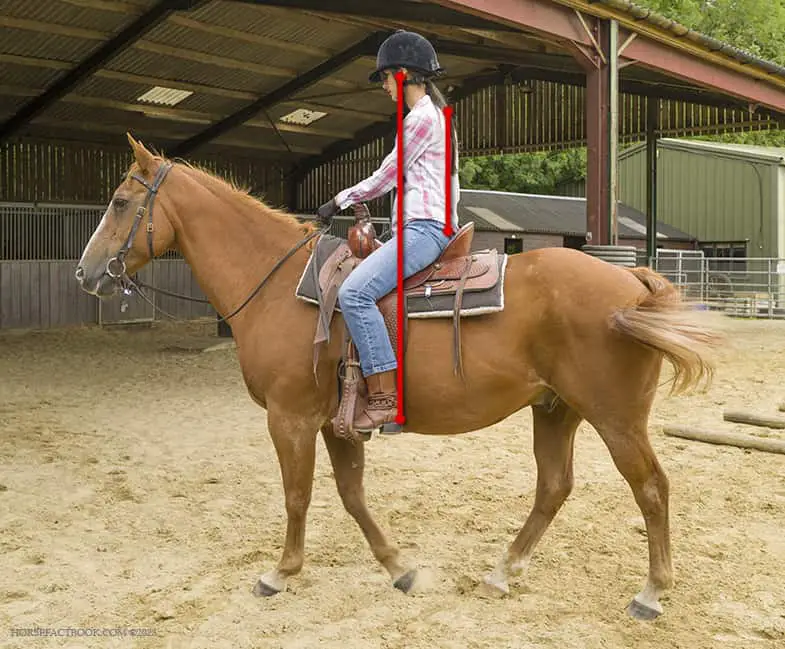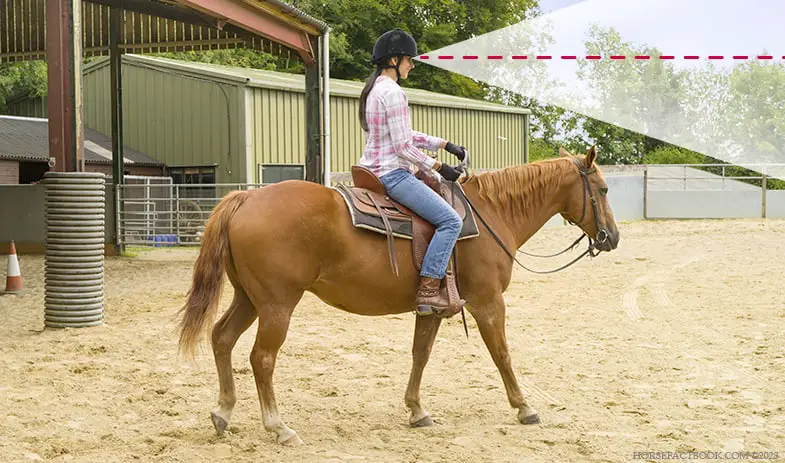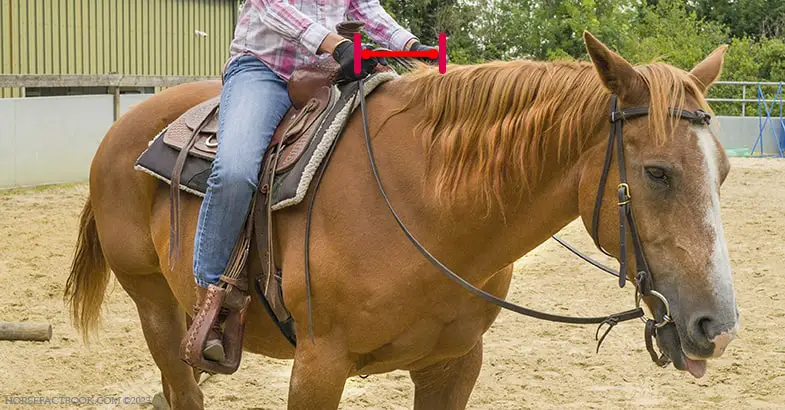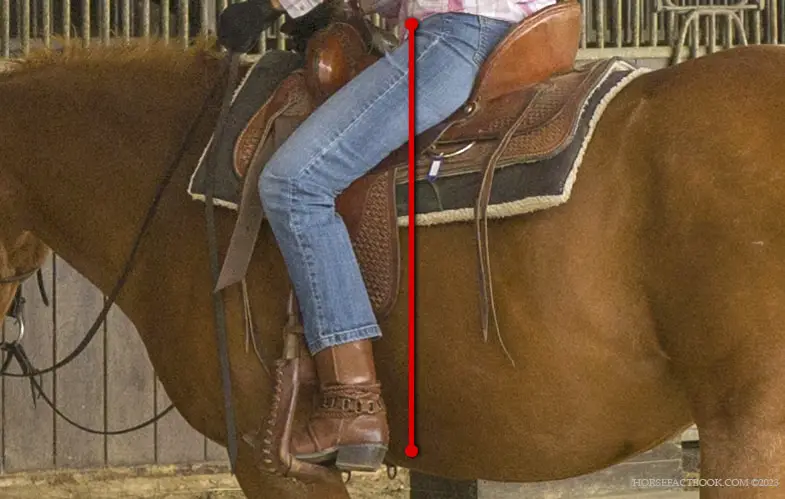When you start learning to ride a horse it’s easy to maintain your posture, after all, your instructor is making sure you keep it but when you start riding out on your own it’s all too easy to relax your position, even if you’re a seasoned pro. As a riding instructor myself, this is something I see all too often, and something I have to admit I’ve fallen foul of myself.
Over the years I’ve tried a variety of different techniques to help me (and others) maintain the correct posture in the saddle. Some haven’t worked so well but I thought it would be helpful if I shared with you the tips and tricks I use to keep my posture.
What should my posture be when horseback riding?
In order to make sure you have the right posture when you’re horseback riding you should imagine a straight line from the middle of your ear going down to your shoulder, hip, and ultimately just behind your heel. Your stirrups should be of equal lengths and you shouldn’t be able to see your toes or heels if you look down.
From the front, there should be a straight line from your chin to your breastbone, belly button, and down to your pubic bone. If you continue this imaginary line down it should line up with your horse’s spine.
For quick reference your posture should be as follows:
- Your head should be held high with your eyes looking forward.
- Your shoulders should be level, straight, and slightly back.
- Your chest should be out with your stomach being flat.
- Your back should be straight but relaxed.
- You should be sitting squarely with your weight on both seat bones.
- Your legs should be close to the horse’s side without gripping.
- The balls of your feet should be resting on the treads of the stirrups.

Why is posture important in horseback riding?
As a rider, you want to be able to communicate properly with your horse which is why posture is so important, your control of the horse will depend on it. If you’re not sitting correctly with good posture and the right riding position then you won’t be able to give your horse effective aids and will therefore be giving them poor commands at best.
As well as allowing you to connect with your horse properly, having a good seat and correct posture will also help you (and your horse) to be better balanced. If you constantly ride without having the right posture, in time, you’ll be at a greater risk of developing neck and back issues.
Poor posture will also have a negative impact on your horse, it’ll create tension in your body which will lead to confusion in the horse with your commands being misinterpreted or misunderstood.
How can I improve my horseback riding posture?
Having, and maintaining, the correct horseback riding posture (and position too for that matter) is all about muscle memory. The more you do something the easier it is to do but by the same token, this can also make it harder to break bad habits.
Your posture isn’t one single thing, everything from your head (including your eyes) to your toes plays a part in how you sit in the saddle which is why I’ve decided to break it up into different parts. I also wanted to explain why they made a difference to your posture.
Below are some of the tips and tricks I use to help myself (and my students) maintain the correct posture all of the time.
Head
As well as being one of the most common of all mistakes we as equestrians make it can also have the biggest impact on our overall posture, as well as on our ability to stay in the saddle. Looking down, even for a second, will inadvertently cause you to tip forward, changing your center of gravity. This shift will unbalance you, making it harder for you to stay in the saddle if your horse trips or suddenly stops. It’ll also stiffen your spine which will make it harder for your horse to carry you.
As a riding instructor, I’m forever telling my students to keep their heads up and look forward but found that telling them wasn’t effective as within a few minutes they’d look down again. Instead, I decided to ask them to look at an object at least ten feet in front of them. I then ask them to describe the object to me and see if I could work out what it is that they were looking at. This makes it more fun which encourages them to keep their head up.
When I’m riding on my own I still do this although I change it slightly in that I like to look out for different animals or plants and see if I can work out what they are before I get close enough to tell what they are (or before they run away if its an animal).
Shoulders
It can be easy to let your shoulders droop if you’re out riding for a long time but doing so will, like looking down, cause your balance to shift forward over your horse’s withers. At best this will force your horse to work harder to compensate for your lack of balance. It can also make your horse nervous ad increase your risk of falling if your horse stops unexpectedly. Ultimately your shoulders determine your balance, if they’re right so will your balance be.
In order to encourage my students to keep their shoulders back I use a riding crop, don’t worry I don’t hit them (or the horse) with it! Instead, I place the crop between their elbows and behind their back. This not only forces them to keep their shoulders back as they’re unable to move them forward, but it also helps them to keep their elbows bent.
For riders that also tip forward I place another crop vertically along their spine in front of the horizontal one. This means that if they start to slouch forward the crop behind their elbows will stop them from doing so.
Hands
There are a few reasons why it’s important to make sure you’re holding both your hands and the reins correctly. Having your thumbs on the top of your hands will not only help to you communicate properly with your horse but it will also work to steady your hands and prevent any unnecessary pull on the horse’s mouth. Likewise, if you bend and twist your wrists or hold your hands too far apart (or even too close together) then you’re reducing the effectiveness of the reins which in turn means that your commands won’t be smooth and could easily be misinterpreted by your horse.
I find the best way of keeping your thumbs up is to place a ruler or yardstick between your thumbs and hands. This makes it impossible for your wrists to twist but will also stop you from dropping your thumbs. I appreciate it will probably be difficult and uncomfortable at first but in time it’ll become second nature and you won’t need the ruler at all.
If you bend your wrists and end up turning your hands either inward or outwards then you can use tongue depressors to help keep your wrists facing in the right direction. Simply tape them to the inside and outside of your wrists and, bingo, your wrists are always straight.
If, on the other hand, you hold your hands more than 4 to 5 inches apart you can easily fix this by attaching a snaffle bit (ideally with a Mullen mouthpiece) to your reins and hold that as well. This will tell you exactly how far apart your hands should be, especially if it’s one of your horse’s old bits.
Interested to know more about bits? Everything you need to know about bit & mouthpieces.
Back
There’s a popular misconception amongst non-horseback riders that we just sit on the horse and let them do all of the work but this couldn’t be further from the truth which is why it’s important to have a strong back and good core strength. Horseback riding is a physical exercise and if you’re not strong enough to support yourself and maintain your posture your horse will have to work twice as hard and will likely be less responsive.
Improving your core is by far the single best way of helping you to maintain your posture when riding. The web is full of core exercises but if you want some simple ones that are perfect for equestrians then you should check out my recent article on core exercises for horse riders. You can also use a harness-type device that will force you to keep your back straight but personally, I don’t like them because they artificially keep you back straight.
If you find that you’re not sitting up straight in the saddle then rather than trying to correct your back it’s better to look at your shoulders. If they’re back then it’ll automatically improve your back as it’s practically impossible to slump forward when your shoulders are back.
Not sure which exercises are good for riding? 13 exercises you can do at home to improve your riding.
Seat
We don’t often think much about how we sit in the saddle (after all how many different ways can you sit down) but if you’re not sitting correctly then not only will you be unbalanced but you’ll also be moving about all over the place, forcing your horse to work much harder.
You should be sitting evenly on both seat bones with your body being in the middle of the saddle but this can fill alien at first which is why I always suggest taking your feet out of the stirrups. I know that this is something a lot of riders hate but it will help you to be centered on your horse’s back as well as to have a deeper seat. In turn, this will allow you to move freely with your horse using your hips rather than your whole body. Riding without stirrups will also help you to understand how your horse is moving and what his back and legs are doing.
Lower legs
While our hands are the most important way for us to communicate with our horses, our legs aren’t far behind which is why it’s vital that they’re in the right place and don’t move around unnecessarily. If they do then your commands won’t be as effective because you’ll be constantly giving your horse mixed messages, albeit unintentionally.
As with improving your seat, riding without stirrups will help but you can also do lower leg lifts. This can be a real killer but will help you to relax your lower leg and keep it still when you’re not giving your horse instructions. To start with take both of your feet out of the stirrups and start by moving one of them away from your horse (while keeping your back straight, and your seat centered). Hold this for a few seconds before repeating for with the other leg. Doing this a few times will help to loosen up hip flexors which will help your lower leg.
Thighs and knees
Gripping too much with your thighs and knees will cause you to be unbalanced and unstable which, in turn, will mean you won’t have as much control over your horse, nor will you be able to give effective aids. It will also mean you’ll have little to no control over your lower legs and won’t be able to move in time with your horse.
In order to loosen your thighs and knees take your feet out of the stirrups and stretch them out in front of you. Hold that for as long as possible (but at least 30 seconds) before putting your feet back in the stirrups. Next move your legs away from the saddle, making sure your seat remains centered, and again hold this for at least 30 seconds.
Once you’re able to do this without any problems you should do it while your horse is moving. To start with you can do this at a walk but in time you should move up to a trot and ultimately a canter, although I wouldn’t advise doing it at a gallop.
Body tension
If you’re tense then not only will you find it harder to hold the correct posture but your horse will also pick up on it, possibly making them nervous and anxious too. I know you might think that it’s too difficult to alter your body tension but it’s actually easier than you might realize.
It might sound silly but breathing will help you to relax, release unnecessary tension and also help to calm your horse. I don’t mean the sort of breathing that we all do every day without thinking about it, I mean taking deep, conscious breaths. The best way of doing this is to focus on taking deep breaths. To do this breathe in for two seconds, hold it for one and then slow exhale for three seconds. Do this continually for one minute and I guarantee you’ll feel better after (and so will your horse).
I hope you found this article helpful. If you did I’d be grateful if you could share it please as it would really help me.
Recommended products
Over the years I have tried hundreds of different horsey products, from various blankets and halters to different treats. Some I’ve loved, others I’ve hated but I thought I’d share with you my top all-time favorite products, the ones I never leave the yard without. I’ve included links to the products (which are in no particular order) that I really think are great.
- Horse Knots by Reference Ready – If you’re like me and enjoy pocket reference guides then you’ll love this knot tying guide. These handy cards can easily fit in your pocket or attach to the saddle for quick reference. They’re waterproof, durable and are color coded to make them easy to follow.
- Mane ’n Tail Detangler – Even if you never show your horse you’ll need to detangle his tail from time to time (and possibly his mane too) which is always a challenging chore! I’ve found that if I run a little bit of detangler through my horse’s tails every few days it stops them from getting matted up and makes combing them easy, even if they’re coated in mud. I don’t know if I should admit to this or not but it also works wonders on my hair.
- TAKEKIT Pro clippers – Over the years I’ve tried a lot of different clippers and while some were obviously better than others I found these to be by far the best. They are heavier than a lot of other clippers but for me, that’s a good thing, it makes them feel more sturdy and hardwearing. On top of that they have a range of speeds so are just as good for clipping your horse’s back as they are his face. I also like the fact that they come in a handy carry case but that’s not for everybody. The company that makes them is super good and incredibly helpful too, a real bonus these days. The only thing I wasn’t keen on was the fact that it doesn’t come with any oil, but that’s not a major problem as it’s not difficult to buy lubricant.
- Shire’s ball feeder – There are so many boredom buster toys out there but I like to use these every day, regardless of whether or not my horses are bored. I find that it helps to encourage my horses to problem solve by rewarding them with treats (or pieces of fruit) but it also mimics their natural grazing behavior which helps to keep them calm and de-stressed.
- Horse safe mirror – This is a strange one that many people are surprised about but I like to put horse safe mirrors in the trailers as well as in the quarantine stalls. It helps to prevent the feeling of isolation by giving the impression of other horses being around. Being herd animals horses can get extremely stressed when they feel that they’re on their own but with these stick-on mirrors, they believe that at least one other horse is with them.
- Rectal thermometer – I know this isn’t glamourous at all but it’s vital for your horse’s well-being to be able to check their temperature and a rectal thermometer is the easiest way of doing this which is why I’ve added it to the list.
Shopping lists
I’ve also put together a few shopping lists of essential items that I’ve found helpful over the years. I’ve broken the lists down into different categories rather than put everything in one massive list 😉



